UML Use Case Diagrams: Tips and FAQ
Contents:
What is a UML Use Case Diagram (UCD), and when should I use it?
How do you know who the actors are in a UCD?
How do you know what to put in the "System" box?
The actors in my diagram have interactions. How do I represent them?
I am trying to represent a sequence of actions that the system performs. How do I do it?
How is a UML Use Case Diagram different from a traditional flow chart?
When do I use the uses arrow?
When do I use the extends arrow?
What is the difference between uses and extends?
The scenario I want to describe branches into several possible outcomes, or has some error conditions. How can I represent that with Use Case Diagrams?
What is a UML Use Case Diagram (UCD), and when should I use it?
UML Use Case Diagrams can be used to describe the functionality of a
system in a horizontal way. That is, rather than merely representing
the details of individual features of your system, UCDs can be used to
show all of its available functionality. It is important to note,
though, that UCDs are fundamentally different from sequence diagrams
or flow charts because they do not make any attempt to represent the
order or number of times that the systems actions and sub-actions
should be executed. There are a number of graphical examples in this
FAQ; you might want to look over them to familiarize yourself with the
look of them.
UCDs have only 4 major elements: The actors that the
system you are describing interacts with, the system itself,
the use cases, or services, that the system knows how to
perform, and the lines that represent relationships between
these elements.
You should use UCDs to represent the functionality of your
system from a top-down perspective (that is, at a glance the system's
functionality is obvious, but all descriptions are at a very high
level. Further detail can later be added to the diagram to elucidate
interesting points in the system's behavior.)
Example: A
UCD is well suited to the task of describing all of the things that
can be done with a database system, by all of the people who might use
it (administrators, developers, data entry personnel.)
You should NOT use UCDs to represent exception behavior (when
errors happen) or to try to illustrate the sequence of steps that must
be performed in order to complete a task. Use Sequence diagrams to
show these design features.
Example: A UCD would be poorly
suited to describing the TCP/IP network protocol, because there are
many exception cases, branching behaviors, and conditional
functionality (what happens when a packet is lost or late, what about
when the connection dies?)
Back to top
How do you know who the actors are in a UCD?
When working from an Action/Response table, itentifying the actors is
easy: entities whose behavior appears in the "Actor's Actions" column
are the actors, and entities whose behavior appears in the "System's
Response" column are components in the system.
If you are working from an informal narrative, a sequence
diagram, or a scenario description, the actors are typically those
entities whose behavior cannot control or change (i.e., agents that
are not part of the system that you are building or describing.) The
most obvious candidates for actors are the humans in the system;
except in rare cases when the system you are describing is actually a
human process (such as a specific method of dealing with customers
that employees should follow) the humans that you must interact with
will all be actors. If your system interacts with other systems
(databases, servers maintained by other people, legacy systems) you
will be best to treat these as actors, also, since it is not their
behavior that you are interested in describing.
Example:
When adding a new database system to manage a company's finances, your
system will probably have to interface with their existing inventory
management software. Since you didn't write this software, don't
intend to replace it, and only use the services that it provides, it
makes sense for that system to be an actor.
Back to top
How do you know what to put in the "System" box?
The system box only appears on the top-level diagram (remember that a
typical UML Use Case description will be composed of many diagrams and
sub-diagrams), and should contain use case ovals, one for each
top-level service that your system provides to its actors. Any
kind of internal behavior that your system may have that is only used
by other parts of the system should not appear in the system
box. One useful way to think of these top-level services is as
follows: if a use case represents a top-level service, then it should
make sense for the actors who interact with it to request only that
service of your system in a single session (in whatever sense a
"session" is intelligible in your system.)
Example: In the diagram below we would like to
represent the use cases for a camera. Suppose we choose "Open
Shutter", "Flash", and "Close Shutter" as the top-level use cases.
Certainly these are all behaviors that a camera has, but no
photographer would ever pick up their camera, open the shutter, and
then put it down, satisfied with their photographic session for the
day. The crucial thing to realize is that these behaviors are not
done in isolation, but are rather a part of a more high-level
use case, "Take Picture". (Note that it does make sense for a
photographer to "Take Picture" just once during a session with their
camera.)

Back to top
The actors in my diagram have interactions. How do I represent them?
If there are interactions between the actors in your system, you cannot represent those interactions on the same diagram as your system. What you can do instead is draw a separate UCD, treating one of the actors itself as a system, and your original system (along with the other actors) as actors on this new diagram.
Example: Suppose you wanted to diagram the interactions between a user, a web browser, and the server it contacts. Since you can only have one system on the diagram, you must choose one of the obvious "systems", such as the server. You might then be tempted to draw interaction lines between the actors, but this is a problem because it isn't clear what the interaction means, so it isn't helpful to show it here. A more useful solution would be to draw two diagrams, showing all of the interactions, as below.
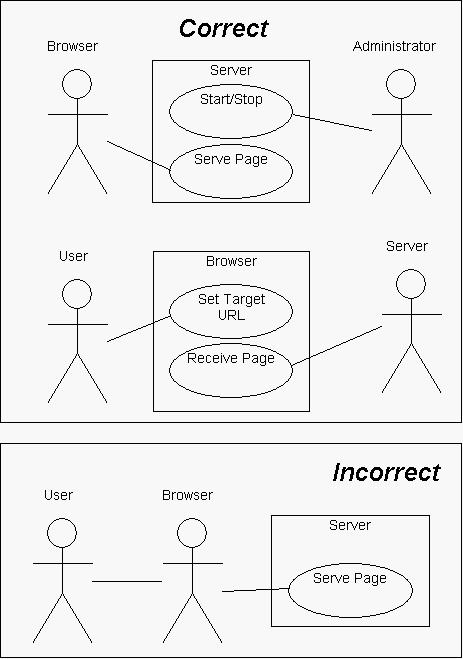
Back to top
I am trying to represent a sequence of actions that the system performs. How do I do it?
Using a UML Use Case Diagram, you can't. UCDs are meant to be a
top-down, horizontal description of functionality, not a blow-by-blow
desrciption of behavior. For the most part, it isn't a good idea to
try to represent sequences of actions with Use Case diagrams. You
should use a Sequence Diagram or a traditional flow chart instead.
(It is possible to represent simple branching conditions with a UCD,
as described below, but you should use this technique sparingly
because it can render a diagram unreadable.)
Back to top
How is a UML Use Case Diagram different from a traditional flow chart?
As mentioned above, UCDs represent functionality in a top-down way, whereas flow charts represent behavior in a linear, time-based way. Also, the way you develop them is all-together different.
Example: (This text refers to the diagrams below.) When
constructing a UCD, the initial step is to identify all of the
top-level behavior. Once you have done this (not a very tricky
process) you have already described, at least in a high-level way, all
of the things your system knows how to do. You can then continue to
add detail by decomposing your use cases into more use cases which are
used by the top-level use cases. At every stage of
development, though, your UCD is a complete description of the
system's functionalty: it may lack detail, but it will not lack
feature set elements. And if functionality or behavior is added or
deleted over the life of your project, the scope of the change you
need to make is proportional to both the scope of the change in the
system itself, and the maturity of your model. This is useful because
it means that when your model is very young (only high-level diagrams
drawn) making sweeping changes to the system does not involve throwing
very much work away. A flow chart, however, does not correctly
describe the system until you have finished drawing it, and even then
small changes in the system will result in significant reworking of
your flow charts. In general, UCDs support the process of analysis
and design much better than flow charts.
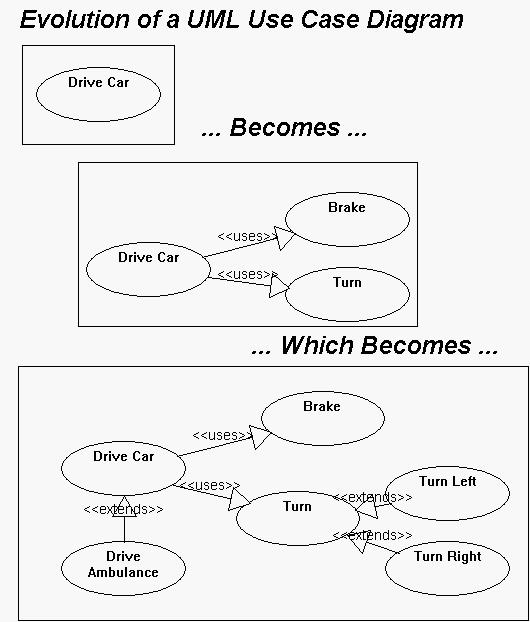
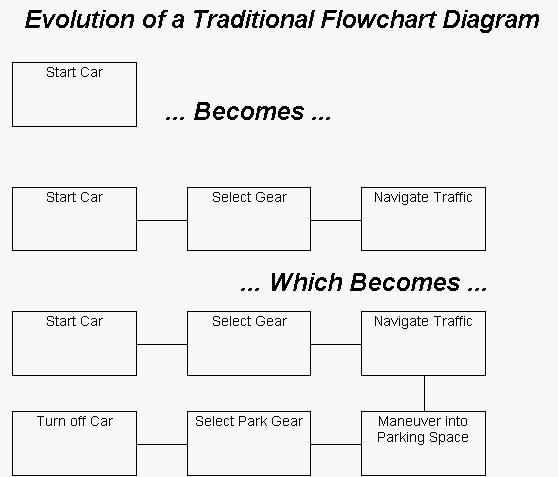
Back to top
When do I use the uses arrow?
The uses arrow (or uses edge as it would be called in
traditional graph thoery) is drawn from a use case X to another use
case Y to indicate that the process of doing X always involves
doing Y at least once (although it may involve doing it many
times, "at least once" is the only relationship guaranteed by this
symbol.) This symbol can be referred to as an aggregation
operator, because it indicates that a given use case is an aggregate
(made up of parts) whose components are the use cases that it uses.
If a certain use case uses several others, that means that all
of the component use cases must be completed in the process of
completing the aggregate use case, although there is no specification
in UCDs of the order in which these are completed. A brief, mnemonic
way to think about the uses arrow is that it it can be read X uses Y
means that "X has a Y" as part of it's behavior.
Example: Suppose you wanted to add detail to the
diagram shown below, representing an airline reservation system.
First, you would create a separate diagram for the top-level services,
and then you would add new use cases that make up the top-level ones.
There is a uses edge from "Check in Passenger" to "Weigh Luggage" and
from "Check in Passenger" to "Assign Seat"; this indicates that in
order to Check in a Passenger, Luggage must be Weighed and a Seat must
be Assigned. Similarly, the diagram indicates that in order to add
a reservation to the system, the available space must be checked and
the passenger's information must be recorded. You could imagine
breaking these use cases down further to show more detail.
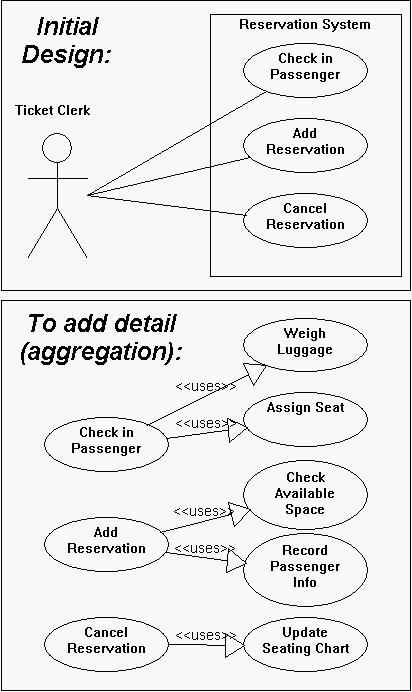
Back to top
When do I use the extends arrow?
The extends arrow (or extends edge) is drawn from a use
case X to a use case Y to indicate that the process X is a special
case behavior of the same type as the more general process Y. You
would use this in situations where your system has a number of use
cases (processes) that all have some subtasks in common, but each one
has something different about it that makes it impossible for you to
just lump them all together into the same use case.
Example: Suppose you wanted to add detail to the
diagram shown below, representing an airline reservation system.
Specifically, what you would like to show is that not all of the seats
aboard the airplane are exactly alike (some window and some aisle
seats), and sometimes passengers will express a preference for one of
these types of seats but not the other. But of course, they cannot
just be given their preference right away, because the seat they want
might not be available. Therefore, the process of assigning a window
seat involves checking for the availability of window seats, whereas
the process of assigning an aisle seat involves checking for the
availability of aisle seats. But even though these processes are
different, they are quite similar in a number of other ways, so it
doesn't make sense to ignore their similarities. Fortunately, UML
lets us have both: we write that assigning these two types of seats
are different processes, but they are similar in that both
processes extend a common, more general process (assigning
seats.)
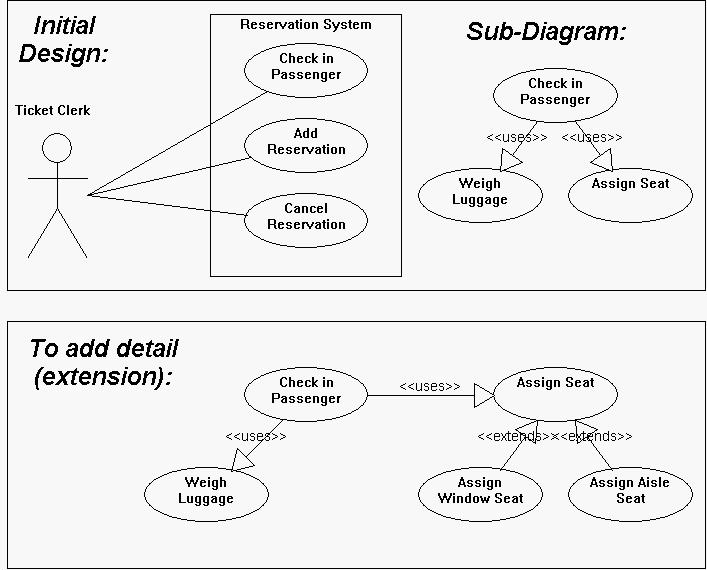
Back to top
What is the difference between uses and extends?
Probably the best way to think about these diagram elements is as follows:
- "X uses Y" indicates that the task "X" has a
subtask "Y"; that is, in the process of completing task "X", task "Y"
will be completed at least once.
- "X extends Y" indecates that "X" is a task fo
the same type as "Y", but "X" is a special, more specific case of
doing "Y". That is, doing X is a lot like doing Y, but X has a few
extra processes to it that go above and beyond the things that must be
done in order to complete Y.
Example:indicates that inorder to successfully
"Check-in", you must "Weigh luggage" and "Assign a seat", some number
of times, in some order. The key, though, is that all UCs used by a
use case MUST BE DONE before that use case be considered to be
complete. Once you realize that there are several types of seat
assignment, you might be tempted to draw a diagram using the
uses edge like the one below, but this doesn't make sense: This
diagram says that in order to assign a seat you must assign both a
window seat AND an aisle seat to the passenger. Never fear, however;
this situation is correctly handled by the extends
relationship. Using the extends relationship (as shown in the
following diagram), we can express that there are two ways to
assign a seat: assigning a window seat and assigning an aisle seat,
but only one need be completed in the process of assigning the
passenger a seat.
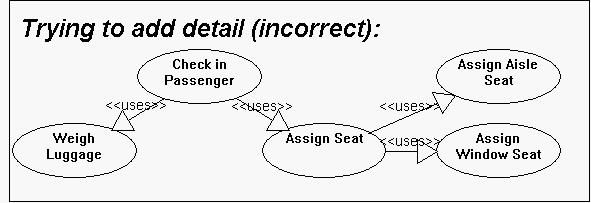
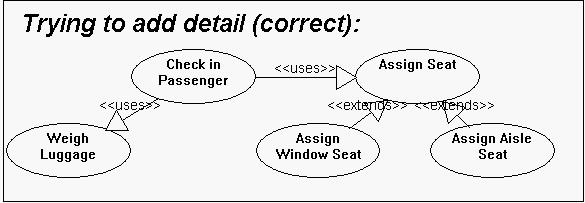
Back to top
The scenario I want to describe branches into several possible outcomes, or has some error conditions. How can I represent that with Use Case Diagrams?
Representing failure and branching conditions is often best done with
a Sequence Diagram or flow chart, but there are some grey-area cases
when it isn't clear whether or not a Use Case Diagram is appropriate.
A rule of thumb: if in representing the branching actions in the Use
Case Diagram you must add significantly more use case ovals, and the
resulting diagram is muddy or confusing, consider using a different
diagramming style.
With that said, it is possible to represent simple branching
behavior with UCDs, although I would like to again stress that UCDs
ARE NOT FLOW CHARTS. This is done by realizing that if the use
case, or process that you are trying to represent can have two
significantly different outcomes (success and failure, for example),
then that means that you really have two different use cases: one in
which the process succeeds, and one in which the process fails. Of
course, these two use cases are related in that they are both
extensions of the original use case, so you would draw the
original use case with the two branches extending from it. I consider
this almost an abuse of the meaning of the extends edge,
because it really isn't being used here to represent a taxonomy of use
cases (which is its purpose) but is instead taking advantage of the
specific abstract definition of the relation to hack flow-chart-like
behavior out of the UCD style. Again, USE THIS TECHNIQUE
SPARINGLY; IT CAN QUICKLY MAKE A DIAGRAM UNREADABLE.
Example: Suppose that we want to represent the use
cases of a normal CD player. When all goes well, the CD player
retracts the tray upon which the CD sits, reads it, and starts
playing. (The use case for this behavior is represented below. The
top-level diagram has been omitted for brevety.) Unfortunately, some
users will command the system to play a CD even when there is no CD in
the tray. We therefore have a failure condition, under which the
system must do something other than play the CD (namely, prompt the
user for a CD.) To represent this, we modify the normal diagram with
some extra use cases, in which the presence of the CD is
verified. The behavior of playing the CD extends the
behavior of verifying that the CD is present in that it is the
special case of verifying the CD's presence in which the CD
is present. The other special case of verifying the CD's
presence is that this is done and the CD is not present, so the
user is prompted for a CD. I will say one last time that this use of
extension is a bit of a reach, but it is an elegant way to express
multiple behaviors of a single use case when the number of such
behaviors is small.
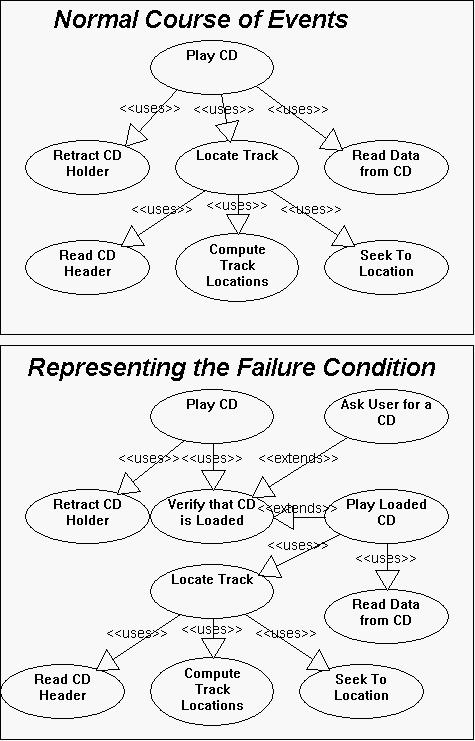
Back to top
Maintained by Rus Heywood








